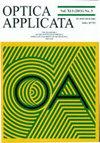基于稳健设计方法的背光模组光学均匀性因素优化
IF 0.5
4区 物理与天体物理
Q4 OPTICS
引用次数: 1
摘要
为了迎接高清液晶显示(LCD)时代的到来,除了高质量的面板制造技术外,背光模块如何能够提供更高均匀度的均匀背光,以获得更好的观看体验,是一个非常重要和迫切的问题。本研究以15.6英寸侧入式背光模组为基准,采用田口法寻找高均匀性。鱼骨图的匹配影响背光模块的光学均匀性系数,如导光板点的大小、塑料框架的颜色、导光板固定凝胶的颜色、反射面的差异等。根据正交表使用光学模拟软件LightTools。得到平均均匀性特性的信噪比(S/N),并将其转化为因子响应表和因子反应图的最佳响应因子。13点均匀性高达90.12%,比原设计系数提高4.72%。通过方差分析可以得到四个因素对均匀性的贡献。最后讨论了各因素水平对均匀性的影响。本文章由计算机程序翻译,如有差异,请以英文原文为准。
Optimization of optical uniformity factors of backlight module using robust design method
In order to meet the advent of the high-definition liquid crystal display (LCD) era, in addition to the high-quality panel manufacturing technology, how the backlight module can provide a uniform backlight with higher uniformity for a better experience in viewing, is a very important and urgent issue. In this study, the 15.6-inch side-in backlight module was used as the benchmark, and the Taguchi method was applied to find the high uniformity. The matching of the fishbone diagram affects the optical uniformity factor of the backlight module, such as the size of the light guide plate dot, the color of the plastic frame, the color of the fixed gel of the light guide plate, and the difference of the reflection surface. The optical analog software LightTools is used according to the orthogonal table. The signal-to-noise (S/N) ratio of the average uniformity characteristics is obtained, then it is converted into the best response factor of the factor response table and the factor reaction diagram. The homogeneity at 13 points is as high as 90.12%, which is 4.72% higher than the original design factor. The contribution of the four factors to the uniformity can be obtained by using the variance analysis. Finally, the influence of each factor level on the uniformity is discussed.
求助全文
通过发布文献求助,成功后即可免费获取论文全文。
去求助
来源期刊

Optica Applicata
物理-光学
CiteScore
1.00
自引率
16.70%
发文量
21
审稿时长
4 months
期刊介绍:
Acoustooptics, atmospheric and ocean optics, atomic and molecular optics, coherence and statistical optics, biooptics, colorimetry, diffraction and gratings, ellipsometry and polarimetry, fiber optics and optical communication, Fourier optics, holography, integrated optics, lasers and their applications, light detectors, light and electron beams, light sources, liquid crystals, medical optics, metamaterials, microoptics, nonlinear optics, optical and electron microscopy, optical computing, optical design and fabrication, optical imaging, optical instrumentation, optical materials, optical measurements, optical modulation, optical properties of solids and thin films, optical sensing, optical systems and their elements, optical trapping, optometry, photoelasticity, photonic crystals, photonic crystal fibers, photonic devices, physical optics, quantum optics, slow and fast light, spectroscopy, storage and processing of optical information, ultrafast optics.
 求助内容:
求助内容: 应助结果提醒方式:
应助结果提醒方式:


